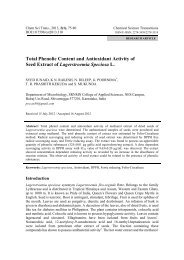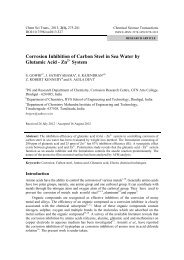novel spectrophotometric methods for the quantitative analysis of ...
novel spectrophotometric methods for the quantitative analysis of ...
novel spectrophotometric methods for the quantitative analysis of ...
- No tags were found...
Create successful ePaper yourself
Turn your PDF publications into a flip-book with our unique Google optimized e-Paper software.
14 Chem Sci Trans., 2013, 2(1), 13-18<br />
clinical studies and no stability indicating method is available in <strong>the</strong> <strong>of</strong>ficial compendia<br />
using HPLC <strong>for</strong> analysing RFM in dosage <strong>for</strong>ms. Analytical <strong>methods</strong> <strong>for</strong> RFM from<br />
pharmaceutical dosage <strong>for</strong>m should be developed and validated. To date, all analytical<br />
<strong>methods</strong> described in literature <strong>for</strong> <strong>the</strong> determination <strong>of</strong> RFM in biological fluids involve<br />
liquid chromatography 3-7 and liquid chromatography–mass spectrometry <strong>methods</strong> 8-9 .<br />
Figure 1. Chemical structure <strong>of</strong> rufinamide<br />
Experimental<br />
A double beam UV-Vis spectrophotometer (UV-1800, Shimadzu, Japan) connected to<br />
computer loaded with spectra manager s<strong>of</strong>tware UV Probe was employed with spectral<br />
bandwidth <strong>of</strong> 1nm and wavelength accuracy <strong>of</strong> ±0.3 nm with a pair <strong>of</strong> 10 mm matched<br />
quartz cells. All weights were taken on electronic balance (Denver, Germany). For scanning,<br />
<strong>the</strong> wavelength range selected was from 400 nm to 200 nm with medium scanning speed.<br />
All experiments were per<strong>for</strong>med at room temperature (25±1) °C.<br />
Reagents and chemicals<br />
Rufinamide standard (purity ≥ 98.0%) was obtained from Eisai Pharmaceuticals<br />
(Visakhapatnam, India). Rufinamide is available commercially with brand names<br />
Pr BANZEL ® and BANZEL ® (containing 100, 200 and 400 mg <strong>of</strong> <strong>the</strong> drug content)<br />
respectively and were procured from <strong>the</strong> local market.<br />
Preparation <strong>of</strong> stock and sample solution<br />
The standard solution <strong>of</strong> rufinamide was prepared by dissolving accurately about 25 mg <strong>of</strong><br />
<strong>the</strong> rufinamide with acetonitrile in a 25 mL volumetric flask.<br />
Preparation <strong>of</strong> phosphate buffer (0.02 M) pH 8.0<br />
50 mL <strong>of</strong> 0.2 M potassium di hydrogen phosphate was mixed with 46.8 mL <strong>of</strong> 0.2 M sodium<br />
hydroxide and sufficient water to make up to volume in a 500 volumetric flask.<br />
Preparation <strong>of</strong> borate buffer (pH 9.0)<br />
6.2 g <strong>of</strong> Boric acid was dissolved in 500 mL <strong>of</strong> water and pH was adjusted to 9.0 with 1.0 M<br />
sodium hydroxide and diluted with water in a 1000 mL volumetric flask. The stock solution<br />
was fur<strong>the</strong>r diluted with phosphate buffer pH 8.0 and borate buffer pH 9.0 <strong>for</strong> method A and<br />
method B (0.5-30 µg/mL) to obtain required sample solutions.<br />
Procedure<br />
Method A<br />
The drug solution was scanned (200-400 nm) against reagent blank (phosphate buffer pH<br />
8.0) and <strong>the</strong> absorption spectrum (Figure 2) was recorded. The absorption maximum (λ max )<br />
was observed at 206 nm. A series <strong>of</strong> solutions (0.5-30 µg/mL) were prepared and <strong>the</strong><br />
absorbance <strong>of</strong> <strong>the</strong>se solutions was recorded at that λ max .





